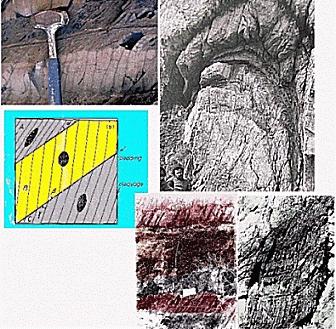
CLEAVAGE REFRACTION
Cleavage refraction occurs in layered rocks, when there is appreciable
rheologic difference in response to stress. The smaller cleavage-hedding
angle is always characteristic of the less competent layers, the greater
angle is found in the more competent layers. The numerical difference in value of the angle is a function of competence contrast
and of the location in the fold. If the geometry of the fold is associated
with higher strains on the overturned limb than on the normal limh (as is
frequent), the cleavage refraction is more marked on the normal limb than
on the overturned limb. Generally the axial surjace of the fold lies with
an orientation between the two directions of the cleavage developed in
competent and incompetent layers. The relationships between refracted cleavage and layering at the fold
crest, indicate that the crest and hinge lines are not coincident. The geometric relationships described above hold true irrespective
whether the fold is an upward or downward facing structure whether this
fold is an antiformal anticline or antiformal syncline etc. definitions .
If the polarity of the layers in a fold can be determined (e.g. with
sedimentation structures such as cross bedding or lithological grading)
then these observations can be combined with cleavage bedding
relationships to determine the jacing direction of a old. Once this facing
direction has been established then the cleavage -bedding relationships at
individual outcrops can be used to determine the stratigraphic polarity of
the beds. Clockwise from top: Refraction in Martinburg formation; refraction on
the western limb of Rhoscolyn anticline; refraction in turbidite sequence
at Barmhan (Mahakoshal group) and interpretation of cleavage refraction as
regards the finite strain state. |